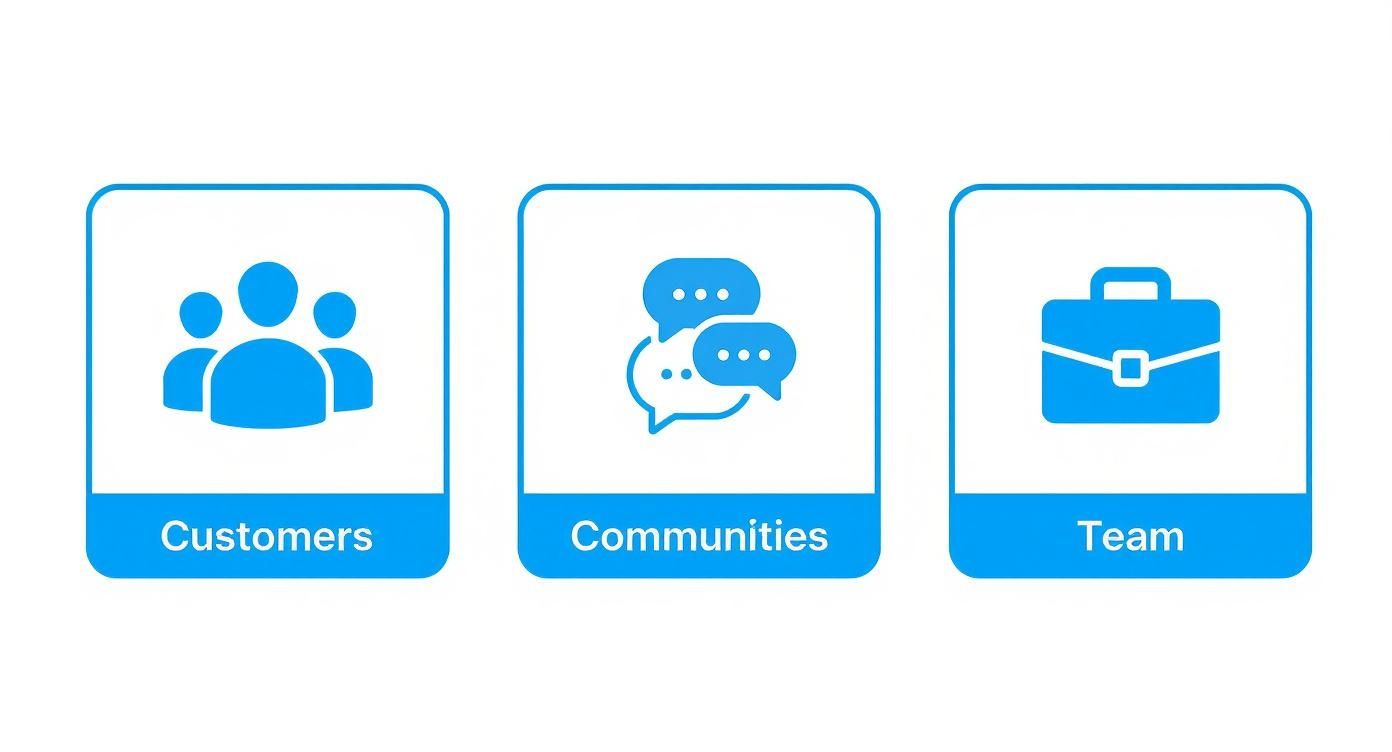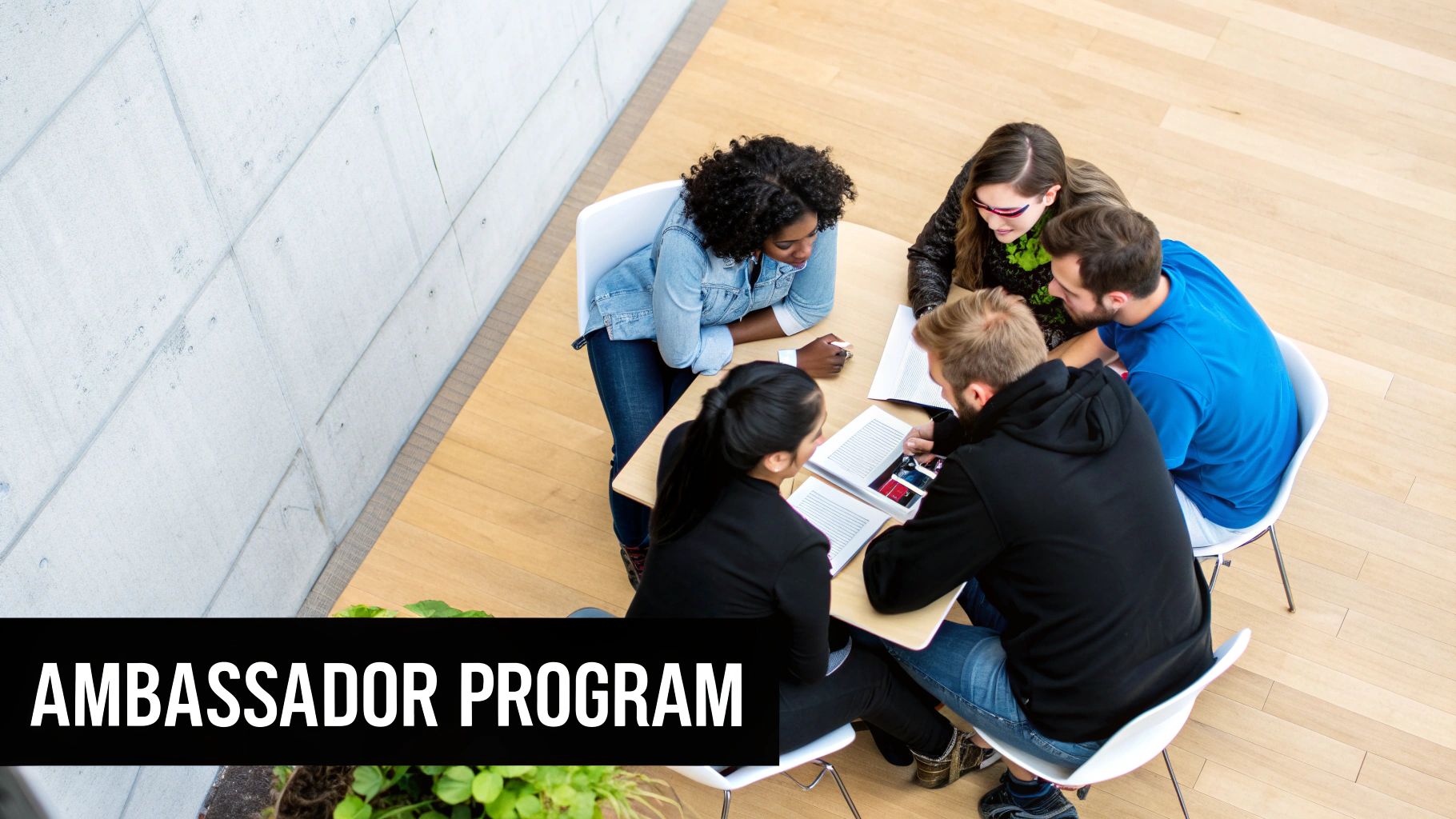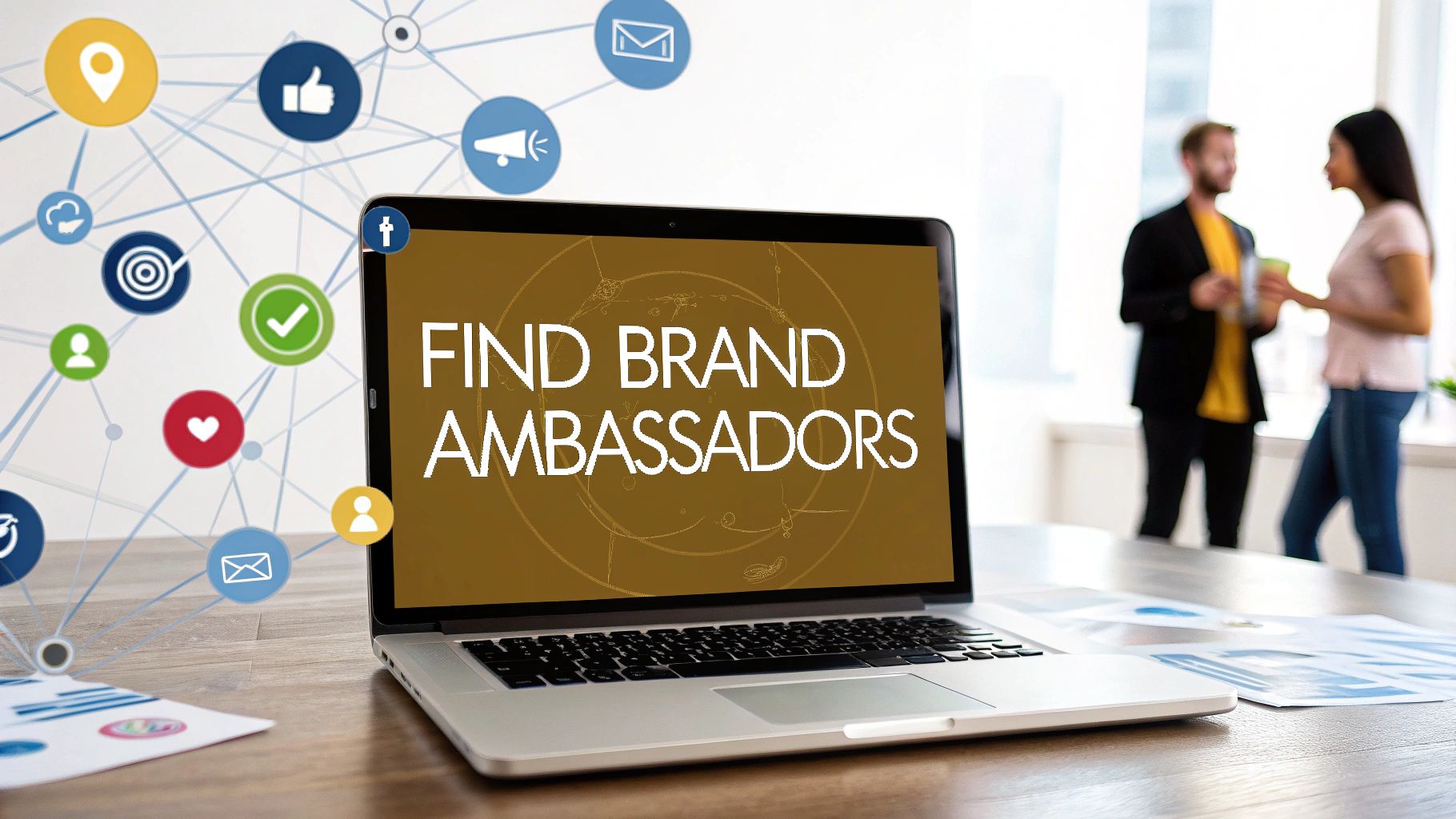Before you can even think about finding brand ambassadors, you have to know exactly who you're looking for. This isn’t about creating a generic persona. It’s about building a detailed blueprint of the individuals whose values, voice, and audience are a perfect match for your brand. Get this foundational step right, and your outreach will be focused and effective from the get-go.
Defining Your Ideal Ambassador Profile

Jumping into the search without a clear profile is like hiring for a key role without a job description—you'll end up wasting time on people who just aren't the right fit. Your mission here is to look past vanity metrics like follower counts and really nail down the core traits of a true advocate for your SaaS.
The best place to start is with your most engaged and loyal users. Who are the people who already love what you do? Dig in and see what they have in common. This is a bit like building out your https://refgrow.com/blog/customer-segmentation-strategies, but you're specifically looking for people with the potential to be public champions.
Key Traits of a Perfect Ambassador
As you build this profile, zero in on a few critical areas. You're looking for people who consistently show:
- Authentic Enthusiasm: They don't just use your product; they genuinely love it. Their praise isn't forced because it comes from real, positive experiences.
- Audience Alignment: Their community should be your ideal customer base. It doesn't matter if a fitness influencer has a massive following if you're selling a B2B analytics tool—the connection just isn't there.
- Strong Community Engagement: Great ambassadors don't just post content and walk away. They're in the trenches, having real conversations and fostering a genuine community in their comments and DMs.
An ideal ambassador is more than a billboard; they are a trusted voice within a specific community. Their recommendation carries weight because it's built on a foundation of credibility and genuine connection with their audience.
This strategic approach is only becoming more important. Recent data reveals that nearly 73% of marketers are planning to increase their brand ambassador budgets, pointing to better authenticity and a stronger ROI as the main drivers.
Think of it this way: you’re not just looking for a mouthpiece, you’re recruiting a partner. Taking the time to properly define this role upfront is crucial, much like mastering the end-to-end recruitment process is for building a great team.
Where to Find Your Future Brand Advocates
Your most powerful brand advocates are often hiding in plain sight. Before you even think about scrolling through influencer marketplaces, the best place to start is right inside your own ecosystem. You're looking for people who already get it—they use your product, love it, and believe in what you're doing.
The search almost always begins with your current customers. These are the people who have real-world experience with your SaaS and can talk about its value from a place of genuine authority. Dive into your user data to find your power users, the folks with the highest engagement, or those who have stuck with you the longest.
Uncovering Advocates in Your Community
Data tells one story, but your digital communities tell another. Keep a close eye on your social media mentions. Who is consistently singing your praises without any prompting? Those unsolicited shout-outs are pure gold.
You'll find similar advocates hanging out in your forums, Slack channels, or other community hubs. Look for the members who are always jumping in to answer questions, share their workflows, and even defend your brand in discussions. These are your ambassadors-in-waiting.
The most compelling advocacy comes from a place of genuine belief. Someone who uses your product daily and sees its impact on their work will promote it with a level of passion that no paid influencer can replicate.
These active members are already doing the job of an ambassador, just unofficially. Your role is to spot them, give them a nod for their efforts, and offer a more formal way to amplify their voice. It's a win-win: you get a passionate advocate, and you strengthen your entire community in the process.
Expanding Your Search Outward
Once you've tapped into your internal network, it's time to look outward. The key is to find the niche corners of the internet where your ideal customers are already having conversations. This approach helps you build a diverse roster of potential ambassadors.
A multi-channel strategy is your best bet for finding authentic advocates. Below is a breakdown of where to look and what to watch out for on each platform.
Channels for Discovering Potential Ambassadors
| Channel | Pros (What to look for) | Cons (What to watch out for) |
|---|---|---|
| Existing Customers | Already familiar with your product; genuine testimonials; high-engagement users. | May not have a large existing audience. |
| Social Media | Easy to spot organic mentions and public praise; access to diverse audiences. | Requires consistent monitoring; can be noisy and hard to filter. |
| Online Communities | (e.g., Reddit, Slack, Discord) Find highly engaged experts and problem-solvers who are trusted by their peers. | Can have strict rules about self-promotion; building trust takes time. |
| Industry Bloggers | Established authority and credibility; have a built-in, relevant audience. | May expect monetary compensation; outreach needs to be highly personalized. |
| Your Own Team | Deep product knowledge; genuine passion for the company's mission. | Perceived as biased; may not have a strong external network. |
This table should give you a solid starting point for where to focus your energy. Remember, the goal isn't just to find people with a lot of followers, but to find people who have genuine influence and respect within their specific circles.
Here are a few more places to consider:
Niche Online Communities: Dig into specific subreddits, LinkedIn Groups, or private forums where professionals in your industry gather. Look for the most active and helpful members.
Industry-Specific Bloggers: Many experts and thought leaders run blogs with dedicated followings. Learning how to find bloggers in your niche can connect you with influential voices who are respected for their expertise.
Your Own Team: Don't forget the people in your own building! A passionate employee can be an incredible advocate, especially if they have a professional presence in your industry and are excited to share an insider's look at your mission and product.
Vetting Ambassadors for Authentic Alignment
So, you've got a list of potential partners. Now the real work begins. It’s time to look past the follower counts and dig into the stuff that really matters—the qualitative signals that show who's a genuine fit and who's just got a big audience.
Start by getting a feel for their content. Is their voice authentic? Does it resonate? The best ambassadors don't just broadcast; they start conversations. Dive into the comment sections of their posts. Are people leaving thoughtful replies, or is it just a sea of "Great post!" and fire emojis? That tells you a lot about the quality of their community.
This infographic lays out the common places to find great ambassadors, which should look a lot like the list you've just built.

As you can see, your top candidates are probably hiding in plain sight: your customers, your community members, and even your own employees. Each group requires a slightly different approach to vetting.
Analyzing for Red Flags
When you're sizing up candidates, you have to keep an eye out for warning signs. Trust me, a little due diligence now can save you from a massive brand headache down the road.
Here are a few critical red flags to look for:
- Weird Engagement Ratios: If someone has 100,000 followers but their posts barely crack a few dozen likes and comments, something’s off. It could be a sign of bought followers or a completely checked-out audience.
- Value Misalignment: Go back through their old content. Does anything they've said or done clash with your company's core values? Partnering with someone whose public persona is at odds with your brand is a quick way to lose credibility.
- Bot-Like Interactions: Be skeptical of superficial engagement. If you see the same few accounts leaving generic comments on every single post, it might be a sign of bot activity.
The goal of vetting is to find a partner, not just a promoter. An individual's professional history and public persona become an extension of your brand, making a thorough evaluation non-negotiable.
Think of it like hiring. In fact, the principles behind measuring culture fit for selection offer a great framework for figuring out if an ambassador truly belongs in your corner.
And don't forget to screen for outright fraud—it’s more common than you'd think. To get up to speed on what to look for, check out our guide on how to detect affiliate fraud and keep your program safe.
Crafting Outreach That Actually Gets a Reply
That first message is your make-or-break moment. A generic, copy-and-paste email is a guaranteed one-way ticket to their trash folder, and it completely wastes all the effort you put into finding great people. To succeed, your outreach needs to feel less like a cold pitch and more like the beginning of a real conversation.
The secret is personalization that goes deeper than just [First Name]. Before you even think about hitting 'send,' spend five minutes looking at what they've been up to. Did they just drop a killer blog post? Share a really clever workflow on LinkedIn? Mention it.
For instance, ditch the generic "I love your content!" and try something with more substance, like, "Your recent post on scaling product-led growth was spot on, especially your point about user onboarding." This one little change proves you’ve actually paid attention and that you value their expertise.
Structuring Your Message for Success
Keep it short. Keep it respectful of their time. And focus on what’s in it for them. A long, rambling email gets deleted before the second paragraph. Your goal is simply to spark enough curiosity to get a reply, not to lay out the entire program from the get-go.
I’ve found a simple structure that works wonders:
- A genuine compliment: Start by mentioning a specific piece of their work you admire.
- The connection: Briefly explain why you think they in particular would be a great fit.
- The value: Hint at what they'll get out of the partnership.
- A simple ask: Suggest a quick chat to share more, making it easy to say yes.
A great outreach email makes the recipient feel seen and understood. It should be obvious you're reaching out to them specifically, not just blasting a list of people with a decent following. That personalized touch is what cuts through the noise.
And please, don't be afraid to follow up. People are busy. A single, polite nudge about a week later can make all the difference. It shows you’re genuinely interested without being annoying.
Building an Ambassador Program That Lasts

Getting your first few ambassadors on board feels like a massive win, and it is. But the real work is just getting started. It's one thing to find people who are excited about your product; it's another thing entirely to build a program that keeps that fire alive and empowers them to be truly effective.
A lasting ambassador program is all about mutual value. It can't just be a series of one-off transactions. You need a foundation of clarity—they need to know what you expect, but you have to provide that structure without killing their creativity. Slap too many rules on them, and their content will feel scripted and inauthentic, which defeats the whole purpose.
Setting Ambassadors Up for Success
Your main job here is to make it as easy as possible for them to talk about your brand. That means arming them with the right information and tools from day one. You can't expect them to create compelling content if they're guessing about new features or scrambling for a decent logo.
Think about creating a simple resource hub with everything they need in one place:
- Creative Assets: High-res logos, slick product screenshots, and a basic brand style guide.
- Product Insights: Give them a sneak peek at upcoming features and share your product roadmap. This makes them feel like insiders.
- Direct Access: Set up a dedicated Slack channel or have a point person they can reach out to for quick questions.
The most successful programs I've seen treat their ambassadors like an extension of the marketing team. When they feel valued and in the loop, their advocacy becomes genuine and far more powerful. They stop being just promoters and become true partners in your growth.
It's no surprise that as more companies figure this out, the tools to manage these programs are getting better. The market for brand ambassador management software is expected to jump from $2 billion in 2025 to almost $6 billion by 2033. This explosion, tracked in research from Data Insights Market, shows just how critical structured, well-managed programs have become.
Crafting a Compelling Compensation Model
While a genuine love for your product is the best starting point, a smart compensation plan is what keeps ambassadors motivated for the long haul. And no, it's not just about cash. You need to think creatively about how to reward their effort in ways that strengthen their connection to your brand.
For a SaaS company, a hybrid model usually works best. Here are a few ideas to mix and match:
- Affiliate Commissions: This is the most straightforward, performance-based reward. A recurring percentage payout on the customers they bring in is a powerful motivator.
- Free Product Access: Bumping them up to your highest-tier plan is a fantastic, high-value perk that costs you very little.
- Exclusive Experiences: Think about things money can't buy—invitations to company events, early access to beta testing groups, or even a one-on-one feedback session with your head of product.
At the end of the day, a program that lasts is one where your ambassadors feel seen, supported, and fairly rewarded for the value they bring. Get that right, and you'll create a powerful flywheel of authentic promotion that fuels real, sustainable growth.
Got Questions About Brand Ambassadors? We've Got Answers
When you're first kicking off a brand ambassador program, you're bound to have questions. It’s totally normal. Getting these sorted out early on is the key to building a program that actually works for your SaaS without becoming a massive headache.
Let's dive into some of the most common things founders ask.
"How Much Should I Actually Pay a Brand Ambassador?"
This is always the first question, and for good reason. The truth is, there’s no magic number. It really hinges on who the ambassador is, what their reach looks like, and what you’re trying to achieve.
For most SaaS companies, a hybrid compensation model works best. You're not just throwing cash at people; you're creating a partnership.
Here’s a popular way to structure it:
- Recurring affiliate commissions: Give them a cut of the subscription revenue for every customer they bring in. This keeps them motivated long-term.
- Free access to your product: Bumping them up to your top-tier plan is a fantastic, high-value perk that costs you very little.
- One-time cash bonuses: Offer a little extra cash when they hit certain milestones, like their first 10 successful referrals.
"How Do I Know if This is Actually Working?"
Measuring the ROI of your program is another big one. It's easy to get fixated on sales, but that's only part of the story. If you only track revenue, you'll miss the bigger picture.
To get a true sense of the program's impact, you need to look at a few other things:
- Brand Mentions: Are more people talking about your product online? That's a huge win.
- Website Traffic: Give each ambassador a unique tracking link. This shows you exactly how many people they're sending your way.
- Lead Quality: Pay attention to the customers your ambassadors refer. Do they stick around longer? Are they more likely to upgrade? Better customers are a clear sign of success.
An ambassador program isn't just a sales channel—it's a long-term play. You're building an engine for word-of-mouth marketing that grows brand equity and trust over time. That's the real ROI.
"Wait, Isn't This Just Influencer Marketing?"
It's a common point of confusion, but there's a key difference between a brand ambassador and an influencer. People often use the terms interchangeably, but they shouldn't.
Think of it this way: an ambassador relationship is a long-term partnership. It’s built on a genuine love for your product. An influencer campaign, on the other hand, is often shorter and more transactional—a one-off post or video.
Getting this distinction right is crucial, especially as this space explodes. The global market is expected to jump from nearly $10 billion in 2020 to $33 billion by 2025. If you want to stay on top of things, you can discover more insights about brand ambassador marketing and see where the industry is headed. Knowing the difference helps you focus on building authentic, lasting relationships that fuel real growth.
Ready to build and manage your own native affiliate program without the technical overhead? With Refgrow, you can launch a fully customizable referral dashboard directly inside your SaaS in minutes. Join over 1,600 startups who use our platform to track, manage, and scale their partnerships. Start your program today at refgrow.com.

